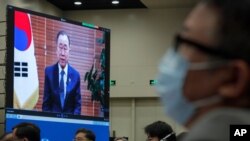China scored points in Southeast Asia against the United States, a rival superpower trying to curtail Chinese influence abroad, through a slate of ministerial visits last week, analysts in the region believe.
Chinese Foreign Minister Wang Yi saw officials in Cambodia, Laos, Malaysia and Thailand from October 11-15, media outlets in China say. His visit followed Defense Minister Wei Fenghe’s trip to Southeast Asia in September.
Wang’s meetings in countries that are historically sympathetic to China, sometimes eschewing U.S. influence, will help counter efforts by Washington to get governments in the 650 million-population Southeast Asian region on its side, the experts say.
U.S. Secretary of State Michael Pompeo pledged in July to support countries threatened by Chinese expansion, and China has irked much of Southeast Asia by fortifying contested maritime features. Earlier this month, Pompeo accused China's governing Communist Party of “exploitation, corruption and coercion.”
“It’s [Wang’s visit is] definitely a response to Pompeo’s call for uniting against the Chinese Communist Party and its policies,” said Carl Thayer, Southeast Asia-specialized emeritus professor at the University of New South Wales in Australia. “It’s a counter-echo.”
The foreign minister’s visits were designed to help China and the host countries discuss details of Asia’s economic recovery, production and supply chains, the Beijing-based, state-controlled Global Times news website reported.
Wang’s tour would also catalyze talks on a code of conduct in the South China Sea, the news outlet said. The negotiating bloc Association of Southeast Asian Nations (ASEAN) wants that code in place in case of new mishaps in the sea where China has expanded its hold on tiny, disputed islets over the past decade. Four bloc members contest China's maritime claims.
“The U.S. has seen the region as an important anchor to strategically and tactically put China in check,” the Global Times says. “Where there is suppression, there are countermeasures. From this point of view, Beijing's strengthening ties with Southeast Asia (are) related to Washington's containment policies against China.”
Southeast Asian states such as smaller, poorer Cambodia and Laos traditionally look to China for infrastructure investment. Chinese investment in Southeast Asia topped $10 billion per year in 2016, though debt issues have slowed projects under China’s $1 trillion-plus Belt and Road Initiative that extends across Eurasia.
Now much of the region is seeking catalysts for economic recovery after shutdowns earlier this year to contain COVID-19. China reopened factories and services in March, earlier than most other countries, after more than a month of lockdowns and has promised to share vaccines with developing countries.
In Laos, to name one example, Wang pledged to provide vaccines and said China would waive tariffs on some goods shipped from Laos to China.
“It’s an easy sell for Wang Yi if you look at the U.S. on COVID handling and the economy,” Thayer said. The U.S. COVID-19 caseload exceeds China’s by more than 95 times. “In other words, China’s going to be around. Its economy is recovering. It’s in the lead of developing vaccines.”
China is probably looking for a stronger victory in Cambodia, said Nguyen Than Trung, Center for International Studies director at the University of Social Sciences and Humanities in Ho Chi Minh City.
The nation of 16 million has been allied with China since the 1960s and its current prime minister, Hun Sen, leans against the United States. Cambodia as an ASEAN member can influence decisions by the whole bloc, including whether to engage or criticize China’s maritime expansion, especially in years when it’s the chair.
“If they can have an impact on the Cambodian decision-making process within ASEAN, I think China can undermine the solidarity of ASEAN countries,” Nguyen said.
Visits to Cambodia and Laos dent the Mekong-U.S. Partnership that launched in September, Thayer added. Cambodia, Laos, Myanmar, Thailand and Vietnam hatched the partnership last month to let in U.S. aid for projects ranging from COVID-19 relief to anti-drought measures. China has rattled those countries, all dependent on the Mekong River, by controlling water flows from within its borders.
Wang visited Europe in August to discuss the pandemic and economic recovery with leaders there, indicating a wider Chinese push to counter U.S. influence, said Oh Ei Sun, senior fellow with the Singapore Institute of International Affairs.
Sino-U.S. relations have spiraled downward this year on a list of trade, technology and consular issues as well as older geopolitical disputes.
“I think he’s going around the world in groups of countries, so now it’s the turn of these nearby Southeast Asian countries,” Oh said. “If the U.S. is going all out, then China is going all out. Both sides would like to have more countries allied to its side.”




